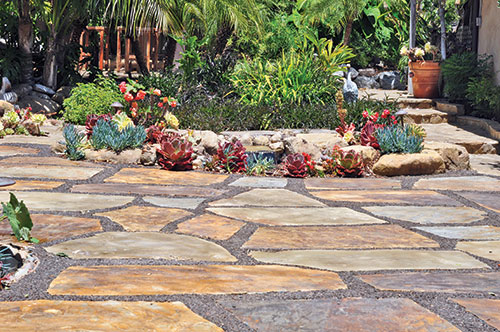Rainwater Capture Installations
Rainwater Harvesting
This backyard used to have a swimming pool, but the yard was transformed into a rain-harvest collection system complete with a pondless waterfall. Harvested water keeps the landscape green year-round, and drought-tolerant plants and porous materials add to the sustainable elements of the project. Paving stones were placed on top of an installation of Flexi-Pave, a porous product that allows for the capture of more rainwater. The rainwater storage tanks sit about 5 feet below this section of the backyard.
Rainwater collection does not have the cache of “cloud computing” and “4G” cellphones and hand-held devices, but the capturing and reuse of rainwater for landscape irrigation and water features are a growing business.
Traditionally, rainwater harvesting was used as a conservation tool. Areas with limited supplies of groundwater would urge their residents and small businesses to harvest rainwater as a method to lessen the use of groundwater. This did not become a widespread phenomenon because the cost of water is usually low, and the few incentives in place urging rainwater harvesting did not justify installing the equipment necessary to harvest rainwater.
The city, state, and federal governments are increasingly touting the benefits of capturing rainwater as a stormwater best management practice tool. For example, Los Angeles, California is promoting low-impact development.
Atlantic Water Gardens’ Clean Rain Ultra Downspout Diverter features a rain head that deflects leaves and debris and a first flush water diverter that prevents contaminants in the initial surge of water from being collected. Rainwater from the gutter flows into this system, with the white PVC pipe serving as the “first flush.” The rainwater flows into the storage containers via the black pipe.
Rainwater for Irrigation
Using rainwater for landscape irrigation would seem to be the ideal use of a natural resource, and many landscape contractors are embracing rainwater harvesting as a tool to achieve more sustainable projects.

Mike Garcia, the owner of Southern California-based Enviroscape, believes in the big-picture view of rainwater capture.
“Los Angeles gets 14 to 15 inches of rain each year,” he said. “Most of that water gets caught in the streets. That water picks up chemicals from the streets, goes down the storm drains, and eventually gets pulled into the oceans. In order to help save the oceans, we should be reusing rainwater.”
Capturing and reusing rainwater is a key component of Garcia’s business. In addition to using rainwater for irrigation, Enviroscape installations use rainwater for pondless waterfalls and water features projects.
Drought-tolerant plants, including Senecio, Aeonium, and Kalanchoes, bring color to the landscape. Rain Bird’s subsurface drip irrigation system (as seen by the copper-colored line) is used to deliver the captured rainwater to the plants.
Replacing the Pool
Garcia converted his own backyard swimming pool into a rainwater collection system that includes a pondless waterfall.
“I can keep the landscape green all year using 2 months of tap water instead of 12 months thanks to the rainwater that has been captured,” he said. Garcia’s backyard includes underground storage for 4,000 gallons of rainwater, a waterfall, and a permeable surface of the storage unit. The rainwater is collected from the roof, flowing from gutters down through to a downspout diverter that filters the rainwater. The filtered rainwater then flows down into the storage tanks.
Garcia’s installation uses a downspout diverter from Atlantic Water Gardens. The company’s Clean Rain Ultra Downspout Diverter features a rain head that deflects leaves and debris and a first flush water diverter that prevents contaminants in the initial surge of water from being collected.
After excavating an area for rainwater storage, a 6-inch minimum sand base is installed. This is followed by the placement of rain tanks. After the tanks are positioned, landscape fabric is used to cover the tanks. A 12-inch sand layer is placed on top of the tanks, followed by a layer of a 45 mm pond liner and a final course of the sand base.
Benefits of Drip Irrigation
The abundance of plant materials on this project is being supplied water via a drip irrigation system, which Garcia says is key in water conservation.
“A subsurface or underground sprinkler system makes great sense,” he said. “Choosing subsurface irrigation over conventional sprinklers will prevent overspray, the main cause of wasted water and money.”
Garcia’s drip irrigation system of choice is Rain Bird’s subsurface drip line with Copper Shield Technology. “This system protects the emitter from root intrusion, resulting in fewer irrigation problems after installation,” he said.
Garcia noted the benefit of subsurface irrigation is to distribute water only where it is needed, at the roots of a plant.
“Drip irrigation is the world’s most efficient type of irrigation, and subsurface drip is especially so because it is unaffected by wind and evaporation,” he said. “This results in 70% less water use than conventional overhead sprinklers.”
Homeowners may not choose to install as many landscape features as Garcia has for his home after getting a rainwater capture system, but Garcia believes there is no harm in adding amenities.
“It’s hard to spend a lot of money on something you cannot see, when for a few dollars more, you can have a waterfall and a pond,” he said.